For most of us, driving had long been a settled science.
We learned the meaning of red and green from the back seat of our parents’ cars. “Stop” might have been the first word we learned to read. Our parents used their turn signals, and they got mad when others didn’t. Pretty soon, we puzzled it all out: driving was just like Kindergarten. You have to follow the rules. You have to take turns, and you have to share. When we finally made it to Driver’s Ed, nobody debated about who had the right of way. It was just a matter of developing some motor skills, after a lifetime of passive training. When we finally got the keys, we never looked back.
But drivers in many parts of the U.S. have since discovered that there was still something new under the sun, after all: the roundabout. About a decade ago, roundabouts began increasingly stepping in to replace the “Stop” signs and traffic lights that we knew so well. They were explained as a more efficient, more effective solution, borrowed from the intrepid drivers of places like Italy and France — places where we vaguely knew we’d never dare to drive. Surely, if they work so well in such challenging locales, they must work even better on our wide and placid streets.
Yet even today, so long after its American debut, the roundabout has managed to elude consensus on its lovability. True, its swirling yellow sign does manage to delight our traveling toddlers. But it often elicits a different reaction in their parents. While many drivers seem to love roundabouts, just as many seem to hate them.
How can something be both good and bad at the same time? Perhaps it’s a matter of design. Let’s take a deep dive into what happens when a traditional intersection is replaced by a roundabout, and try to get at what’s going on.

Innovations in traffic
Intersections have always posed a problem for road design. Building a road is simple, until it encounters another road. There, the two roads have to pass through the same spot. But two vehicles can’t occupy the same spot at the same time, so something really should be done to keep them from trying.
Perhaps the most simple solution is signage. A “Stop” sign simply tells all traffic to stop, and yield right of way to other cars that stopped first. It isn’t perfect. If the intersection is empty, you still have to stop – so it leads to a lot of unnecessary stopping. But it gets the job done.
Somewhat more advanced is the traffic signal. Instead of making everyone stop, every time, it gives over the whole intersection to one road at a time. This isn’t perfect either. Sometimes you’ll be stopped by an overly officious traffic light, dutifully micromanaging an empty intersection. But it gets the job done.
Roundabouts are a bit more clever. The intersection is replaced by a sacrosanct circle, its interior so pure and inviolable it is sometimes planted to daisies. Orbiting around this is a laminar flow of constant motion, consisting of a self-regulating circular pattern that resembles a sort of country square dance. You yield to your partner on the left, and your partner on the right is expected to do the same for you. This means that cars only stop if they have to. It tends to keep traffic moving, reducing bottlenecks and saving some fuel in the bargain. Roundabouts have also been said to reduce the severity of collisions — once drivers have become accustomed to their fluid choreography. This is because traffic becomes oriented at an angle, reducing the possibility of a deadly T-bone collision (although I suspect that the general sense of dread felt by many drivers as they approach a complicated roundabout is also keeping them more alert). Front fenders notwithstanding, the argument is that having small collisions more frequently is better than having huge collisions less frequently.
Mixed opinions
Yet it’s curious that motorists don’t seem to appreciate these benefits very evenly. In Ann Arbor, Michigan, the local newspaper conducted several informal surveys to gauge community reaction to the roundabouts that were being constructed in the area in the early 2010s. Shortly after one roundabout was introduced in 2010, the survey indicated a stark split, at 45 percent “hate” and 37 percent “love” (with 18 percent having no opinion).
We all know that roundabouts take some getting used to. So three years later in 2013, the same newspaper conducted another survey about a similar intersection. It registered virtually the same split at 50 percent “hate” and 43 percent “love.” Interestingly, now only 7 percent were undecided. Instead of reaching consensus, people seemed to be choosing sides.
Although unscientific, these polls seem to align with a prevailing perception about roundabouts – you either love them, or you hate them. A quick internet search reveals polls with startlingly similar conclusions today. It shows that even a technology that brings positive benefits can find itself perpetually lingering in a love-hate relationship with its own users, despite its best intentions.
Squaring the circle
Square dancing is fun, but you have to learn the rules first — and then it takes practice. If you’re enjoying yourself at a party and suddenly someone says, “Let’s all have a square dance,” you’ll feel left out if you don’t know the steps. You might even feel a little resentful to see others gleefully going along with this unsolicited suggestion. So to some, the appearance of a roundabout in their neighborhood must feel a bit like the party that took an unwanted turn for the worse.
Installing a roundabout is certainly a major intervention. Below on the left we see a standard intersection, circa 1990. The two roads intersect at a sharp angle, but beyond that, there’s nothing to make this intersection particularly challenging. This was a four-way stop, with four painted crosswalks that cut across, straight as an arrow, in exactly the place you would expect them to be. On the right, we see that by 2010, this intersection has been flamboyantly reimagined. The roads have been reduced to two lanes apiece, with sizable curbed medians in the center. The crosswalks have been moved backward, to intersect the roads at a right angle. The sparse traffic buzzes right along, largely freed from the need to stop or slow down.
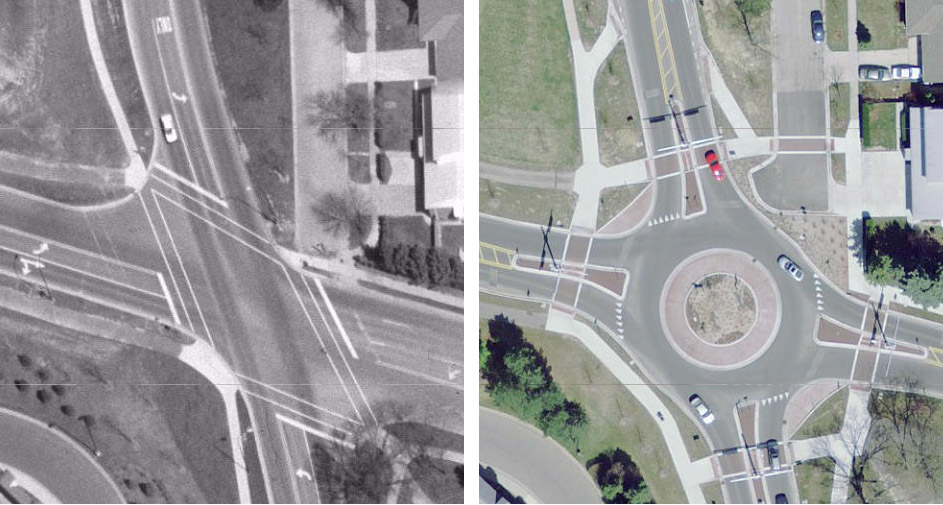
Geometrically, the new layout has about the same amount of road surface, including the circle and the pylons, as the old one (I measured what’s visible in the photos). The crosswalks had to be moved back to accommodate the roundabout, which also reduces the length of each crosswalk that is exposed to traffic. Seems like a win for pedestrians, right? However, the total distance to be walked is significantly longer than before, because the crossings are now farther apart. By my measurements, the walking distance from the northwest corner to the southeast corner is about 50 percent longer than before. So something was gained, but at the expense of something else.
Below is the same intersection from the ground. To remind motorists that there could be pedestrians here, large structures have been constructed to signal the presence of the crosswalks, as traffic speeds obliviously by. So it’s arguable that perhaps some of what the pedestrian gained in a shorter traffic exposure was also lost, in that the traffic is thinking more about how it can keep moving, than about stopping.
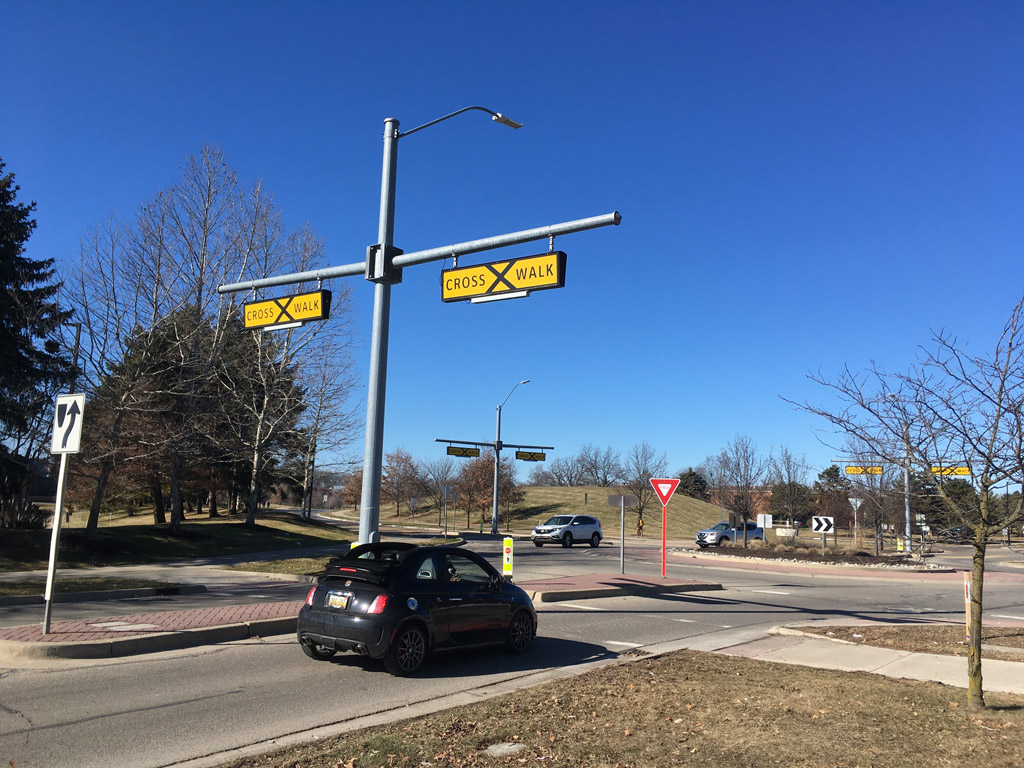
Drivers aren’t terribly challenged by navigating a small roundabout like the one above. But the roundabout’s ambitions are not limited to quiet, suburban intersections. Below, we see another roundabout that has rather adventurously taken over the functions of a high-traffic, high-speed, signaled intersection. My, what a change! At least 21 lanes of traffic have been reorganized into 17, all twisting around the circle. What’s going to happen?
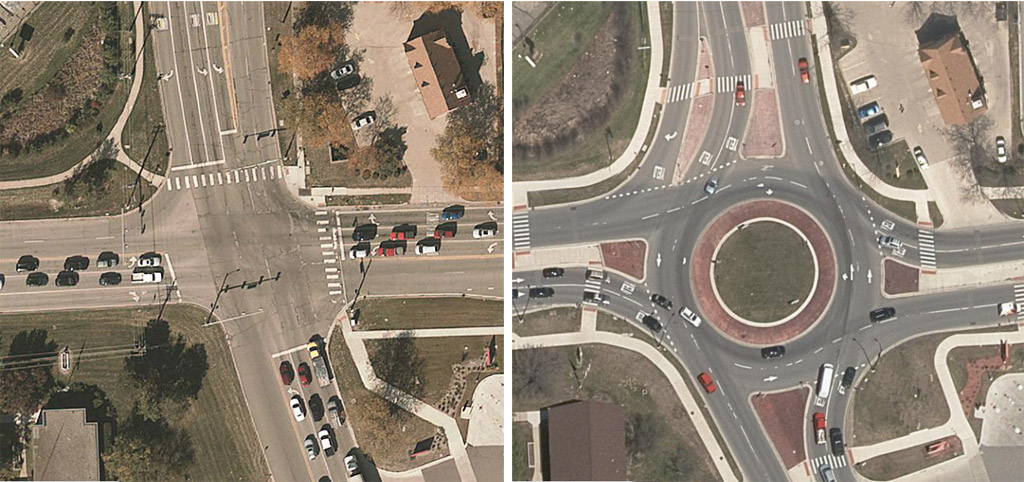
Now, we have multiple lanes segregating themselves early on, with many helpful arrows guiding the way, enforced by unforgiving pylons. There’s no lolling around — you really have to think ahead and keep your head about you. You’ve got to pick your path and go for it. The cars lined up at the old intersection are probably thinking, “What a drag.” But they aren’t clutching at their steering wheels with white knuckles, either.
Geometrically, the road surface visible in the roundabout picture is 30 percent larger than before. Pedestrians are presented with zig-zagging crosswalks, one of which presents three distinct crossings of traffic in a single crossing event. My measurements indicate that the walking distance from the northwest corner to the southeast corner is 75 percent longer than before — and again, the constantly flowing traffic may not be expecting a pedestrian to suddenly cut in, no matter how well marked the crosswalk may be.
Trading off
A big part of the roundabout’s mixed reception, then, is probably derived from the tradeoffs it imposes. As a replacement for a traditional intersection, the roundabout does carry over the major functions we expect of an intersection, but it does so by taking them up and returning them in a slightly modified form — one that delivers certain benefits, but at the cost of others.
Motorists can still get through the intersection, and more quickly on average — but the dynamic, flowing traffic pattern demands more attention than before. You have to keep moving, and you have to actively evaluate your surroundings on the fly, all while orbiting a circular path. Some people make the transition easily, but others seem to lag. Even a seasoned driver can never be certain that the other drivers have learned the rules as well. This means that it always takes a certain amount of spunk to enter a roundabout on the blind faith that the driver to the right will necessarily know to yield. Just as often, we’ll see a confused driver hesitate, look around, and slow to a crawl or stop, unsure how to proceed — then gunning it at exactly the wrong time. Say what you will about traffic lights and “Stop” signs, but everyone knew how to use them.
Neither does the flowing dynamic result in the same kind of permeability to pedestrians that a light or a “Stop” sign would create. Pedestrians can still cross the street, but they have to walk farther, and it’s more imperative that they use the designated crosswalk. They are exposed to traffic for a shorter distance, but that traffic is notoriously harder to read because it doesn’t stop by default. Pedestrians thus have to be more assertive, to be sure that they are seen. When they are seen, the traffic flow suddenly breaks down chaotically, and the hapless interloper takes on a clumsy part in the choreography, often feeling compelled to hurry through, sometimes with an apologetic wave, as if ashamed to have cut in on such a graceful dance. It’s hard to think of a benefit that accrues to the pedestrian, who must not have been at the table when the functions of the traditional intersection were tabulated, and might have preferred its predictable and guilt-free ways.
Adding to the unpredictability for all parties is the tendency for the circular, flowing nature of the intersection to reduce the use of turn signals and obscure any other cues to other drivers’ intentions. Who uses turn signals at a roundabout? Hardly anyone, and when they do, it can be even more confusing, because turning left means bearing right, first. Without an unambiguous signal, other drivers and pedestrians don’t have any idea which part of the roundabout the other car is going to exit.
The lack of predictable patterns of stopping also means that roundabouts don’t create the same kind of orderly gaps in traffic that a traffic light (or to some extent, a “Stop” sign) would create. Instead, the roundabout emits a semi-constant but ragged and unpredictable stream of traffic in all directions, with gaps of widely varying frequency and duration that are more difficult for traffic down the road to anticipate. The creation of gaps in traffic is an unsung function of the traffic light, and one that few people appreciate, even while benefiting from it every time they turn onto a busy road.
For better or worse, where a roundabout is installed, all of these changes are permanent, and all parties must adjust. We gain fuel savings and less congestion, but the new setup may never be as intuitive or leisurely as it was before. This is the transaction that the roundabout presents — and how you feel about it will depend on which set of features you like the best: those that were gained, or those that were lost.
Sacrifice
Innovations of just about every sort include implicit tradeoffs like these. Often, the nature of the trade — or even the fact that a tradeoff exists at all — isn’t made clear until after the fact. Wanting to portray it as a “win-win,” innovators are vested in the need to polish a well-reasoned rationale as to why the replacement set of benefits is better than the original set, and that nothing of importance will be lost. But this proposition requires careful analysis by the user, too.
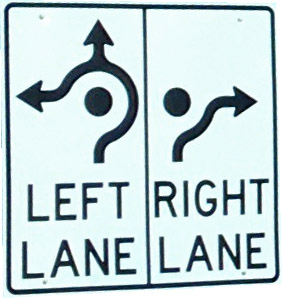
For example, if roundabouts are credited with reducing the frequency of severe collisions (as they often are), this has to be weighed against the possibility that they might increase the frequency of minor collisions (as their detractors claim). Who among us was asked if it was okay to trade the extremely small possibility of a big accident, for a distinctly higher possibility of a small accident? Similarly, who among us was warned that navigating a complex roundabout may always require more attention and care than before, even after we’ve learned the rules? And if we had been asked, how many of us were in a position to answer for both the motorist and the pedestrian? When faced with such decisions, every opinion invites a similarly valid counter-opinion. Who decides?
Mix and match
I’ve long felt that one of the most annoying traits of entrepreneurs and innovators is that they often feel entitled to make judgments on our behalf. It isn’t hard to understand why they do. Any transaction that calls for a tradeoff is a calculated risk — one that is only acceptable if it is deemed to have a sufficiently positive net outcome. The calculating and the deeming are an indelible part of the proposition — but because such assessments are often subjective, they may be subject to unending and thorny debate. To reach a resolution, the designer will often just cut the Gordian Knot and make a decision on everyone’s behalf. Suddenly then, it becomes clear — the need for smooth traffic flow outweighs the need for walkability, and the need to reduce congestion outweighs the need for simple, intuitive navigation. That’s the story, and they’re sticking to it.
But as our polls about roundabouts reveal, defusing the controversy in this way doesn’t prevent it from living on in the users. As motorists continue to group themselves along love-hate lines with respect to roundabouts, no resolution is in sight, except for our eventual acceptance of a vague, lingering dysfunction that splits the population in two. In our increasingly polarized society, perhaps this is par for the course.
One does not need to be either “for” or “against” roundabouts, any more than one needs to be for or against intersections, or for or against travel. Just like “Stop” signs and traffic lights, roundabouts represent a specific solution to the problem of road intersections, one which offers a specific set of advantages and a specific set of disadvantages. How you feel about it depends on where you’re standing.
The important point is that the replacing of one type of intersection with another, or indeed, the replacement of any established solution by a new one, should be recognized by all parties as a transaction — one in which some things will inevitably be traded away in order to gain other things. Regardless of whether one considers oneself a beneficiary or a victim of the roundabout’s rapid rise, the fact remains that it is the outcome of a transaction that was proposed, and collectively accepted (even if only by default). The true “win-win,” for which there are only winners and no losers, is much more rare a beast than the “disruptive” innovators would have us believe. On finding that some things haven’t worked out quite as expected, the natural inclination is to pick a side, from which to attack the other. An alternative might be to examine the process, instead.
Finally, it’s informative to note that in Europe, roundabouts have been common for as far back as most people’s memories manage to reach — and thus are recognized as having a legitimate claim to regulating the intersections that they inhabit. Chances are, our children will feel the same one day… after a childhood of admiring that swirly sign.
Article and photos Copyright 2023.
To subscribe to new posts, visit https://whatshallweweird.com/subscribe/
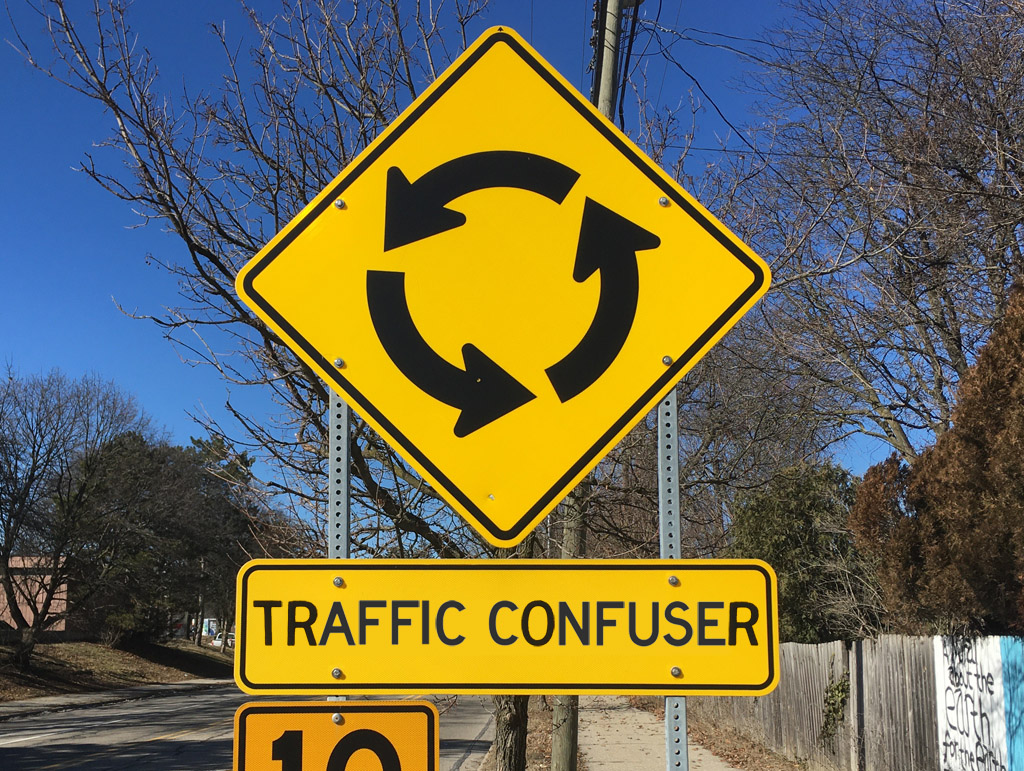


One Comment
Anonymous
Accidents actually increase in roundabouts.